Antonio Alfredo Ferreira Loureiro

CNPq research fellow: A
Research areas: Degrees:
PhD, University of British Columbia, Canadá, 1995
Phone: 5589
loureiro@dcc.ufmg.br
 Home page
Home page
 Lattes
Lattes
 Google scholar
Google scholar Information extracted from Lattes platform
Last update: 2023/05/19ORCID: https://orcid.org/0000-0002-5250-1785
Current projects
| 2017 a Atual | Leveraging Human Behavior and Uncertainty in 5G Networks to Build Robust Resource Allocation and Services Orchestration Models (Embrace) EMBRACE introduces a novel framework to manage heterogeneous resources and operational services. EMBRACE implies to address scientific challenges that rely on collected real-world datasets describing users? network behavior. In particular, the EMBRACE leverages human behavior modeling in terms of their mobility, content demand, interest, and interactions. By building user-aware resource allocation models, EMBRACE aims then better representing uncertainty and human profiling in 5G networks. D2D communication will be also used as operational service to handle the growth of mobile traffic and release cellular network resources, without increasing cost. The novelty of the framework lies in the designed algorithms that will leverage knowledge resulted from users behaviour, network heterogeneity, and uncertainty. The evaluation by simulation and emulation will also be one of the key themes. Finally, involved teams (INRIA INFINE, UFMG, UFG, UTFPR) have a long history of collaboration. Integrantes: Antonio Alfredo Ferreira Loureiro (coordenador), Pedro Olmo Stancioli Vaz de Melo, Aline Carneiro Viana. |
| 2017 a Atual | Projeto de Serviços e Aplicações para IoT A Internet das Coisas (Internet of Things IoT) é a rede de objetos físicos ou ``coisas'' que possuem capacidade de processamento, sensoriamento e comunicação de dados, possibilitando a esses objetos coletar e trocar dados. A Internet das Coisas permite sensorear e controlar objetos remotamente através da infraestrutura existente da Internet, criando oportunidades para uma integração mais direta entre o mundo físico e sistemas computacionais, resultando em maior eficiência, precisão e benefícios econômicos, ambientais e sociais em diversas atividades humanas. IoT tem um amplo alcance, tocando os mais diversos segmentos das atividades humanas, afetando como trabalhamos e vivemos. No entanto, a ampla disponibilidade de dados não traz por si só um valor imediato. Precisamos transformar os diferentes tipos de dados em informação e conhecimento que possam ser úteis, dando origem a uma vasta gama de produtos, serviços e aplicações que serão disponibilizadas nos próximos anos. Para projetarmos serviços e aplicações para IoT devemos investigar problemas básicos como a análise e caracterização de dados, a fusão de dados heterogêneos e a localização e rastreamento de diferentes tipos de dados. Esta proposta trata exatamente disso: da investigação de problemas básicos para projetarmos serviços e aplicações para IoT. Integrantes: Antonio Alfredo Ferreira Loureiro (coordenador). |
| 2013 a Atual | SENUREVE: Serviços na Nuvem para Redes Veiculares Uma VANET (Vehicular Ad-hoc Network) é uma rede ad-hoc formada por veículos equipados com dispositivos de processamento, sensoriamento, comunicação sem fio e interfaces homem-máquina. Uma VANET será um grande passo para a construção de sistemas de transporte inteligentes. A computação em nuvem define um conjunto de recursos virtuais facilmente usáveis e acessíveis tais como hardware, plataformas de desenvolvimento e serviços. Estes recursos podem ser dinamicamente re-configurados para se ajustarem a uma carga variável, permitindo a otimização do uso dos recursos. O objetivo desta proposta é propor serviços de disseminação de informação para passageiros através de computação em nuvem. Integrantes: Antonio Alfredo Ferreira Loureiro (coordenador). |
| 2013 a Atual | Interações entre solo-vegetação-atmosfera em uma paisagem tropical em transformação Ecossistemas terrestres desempenham um importante papel no ambiente global pois controlam de forma significativa as trocas de energia, água e outros recursos entre a atmosfera, superfície terrestre e o solo. Informações detalhadas sobre o funcionamento de ecossistemas (processos ecológicos, dinâmicas sazonais, grau de vulnerabilidade a perturbações e respostas a variabilidade climática) em várias escalas temporais são urgentemente necessárias. Com a perspectiva de mudanças globais iminentes (mudanças climáticas, perda de habitat e biodiversidade e ruptura dos ciclos de carbono e água), essa proposta terá como foco principal o uso de tecnologias de ponta para a coleta de dados ambientais de alta resolução em florestas tropicais intactas e em pastagens com a finalidade de fomentar práticas de manejo que podem auxiliar na manutenção e proteção do funcionamento de ecossistemas sensíveis como as florestas alto-montanas. Nesta proposta pretendemos: 1) combinar novos conjuntos de sensores para adquirir informações sinergísticas sobre plantas e seu ambiente (com medidas simultâneas de crescimento das plantas, uso de água e condições atmosféricas) 2) desenvolver um sistema fechado de sensores que possa oferecer cobertura detalhada e confiável em tempo real de ambientes contrastantes. Nós monitoraremos florestas intactas, pastagens e zonas de transição (borda) usando um conjunto amplo de ferramentas de monitoramento. Ao analisar a dinâmica de água no solo, comportamento da planta toda e condições atmosféricas, nós poderemos conectar a ecologia vegetal com ciclos biogequímicos e o funcionamento de ecossistemas. A aplicação dessas novas ferramentas ao longo de gradientes climáticos e de uso da terra nos possibilitará testar hipóteses sobre os efeitos da fragmentação na dinâmica de água e carbono nos níveis de plantas e fragmentos de flores, dados fundamentais para prevermos os feedbacks entre a biosfera e a atmosfera em uma escala mais ampla. Integrantes: Rafael Silva Oliveira (coordenador), Antonio Alfredo Ferreira Loureiro, Jie Liu, Stephen S O Burgess. |
| 2012 a Atual | Projeto, Algoritmos e Avaliação Experimental de Redes de Sensores sem Fio Redes de sensores sem fio são formadas por pequenos dispositivos distribuídos e autônomos que trabalham de forma cooperativa com o objetivo de monitorar condições físicas e ambientais. Essas redes prometem revolucionar a tecnologia da informação aumentando a nossa capacidade de monitorar e, possivelmente, controlar variáveis do mundo físico. Este projeto de pesquisa trata do projeto, algoritmos e avaliação experimental de redes de sensores sem fio. Em particular, pretendemos aplicar os conceitos de redes complexas nesse projeto para tratar de questões como projeto topológico e algoritmos de roteamento para essas redes. Os objetivos desta proposta são desenvolver uma metodologia de projeto de redes de sensores sem fio a partir da teoria de redes complexas que sirva de base efetivamente para gerar uma solução ``completa'' do ponto de vista de projeto. Integrantes: Antonio Alfredo Ferreira Loureiro (coordenador). |
Current applied research projects
Recent publications
Articles in journals
Combining recurrent and Graph Neural Networks to predict the next place?s category2023. Ad Hoc Networks.
Enhancing Sensing and Decision-Making of Automated Driving Systems With Multi-Access Edge Computing and Machine Learning
2022. Ieee Intelligent Transportation Systems Magazine.
On the prediction of large-scale road-network constrained trajectories
2022. Computer Networks.
Leveraging Urban Computing with the Internet of Drones
2022. IEEE Internet of Things Magazine.
Design Guidelines of the Internet of Drones Location Privacy Protocols
2022. IEEE Internet of Things Magazine.
The Impact of Mobility on Location Privacy: A Perspective on Smart Mobility
2022. IEEE Systems Journal.
Leveraging the self-transition probability of ordinal patterns transition network for transportation mode identification based on GPS data
2022. NONLINEAR DYNAMICS.
A classification strategy for Internet of Things data based on the class separability analysis of time series dynamics
2022. ACM Transactions on Internet of Things.
SocialRoute: A low-cost opportunistic routing strategy based on social contacts
2022. Ad Hoc Networks.
BioMixD: A Bio-Inspired and Traffic-Aware Mix Zone Placement Strategy for Location Privacy on the Internet of Drones
2022. COMPUTER COMMUNICATIONS.
Editorial of ACM MSWiM 2020 Special Issue
2022. COMPUTER COMMUNICATIONS.
Mobility Trace Analysis for Intelligent Vehicular Networks
2021. ACM COMPUTING SURVEYS.
Novel Sustainable and Heterogeneous Offloading Management Techniques in Proactive Cloudlets
2021. IEEE Transactions on Sustainable Computing.
Packet Scheduling in Multipath TCP: Fundamentals, Lessons, and Opportunities
2021. IEEE Systems Journal.
Effects of population mobility on the COVID-19 spread in Brazil
2021. PLoS One.
Exploring Hybrid-Multimodal Routing to Improve User Experience in Urban Trips
2021. Applied Sciences-Basel.
Underwater Sensor Networks for Smart Disaster Management
2020. IEEE Consumer Electronics Magazine.
Road Data Enrichment Framework Based on Heterogeneous Data Fusion for ITS
2020. IEEE TRANSACTIONS ON INTELLIGENT TRANSPORTATION SYSTEMS.
Vehicular Traffic Management Based on Traffic Engineering for Vehicular Ad Hoc Networks
2020. IEEE Access.
From Mobility Traces to Knowledge: Design Guidance for Intelligent Vehicular Networks
2020. IEEE NETWORK.
A distributed and low-overhead traffic congestion control protocol for vehicular ad hoc networks
2020. COMPUTER COMMUNICATIONS.
Uncovering spatiotemporal and semantic aspects of tourists mobility using social sensing
2020. COMPUTER COMMUNICATIONS.
Skipping-based handover algorithm for video distribution over ultra-dense VANET
2020. Computer Networks.
Automatic extraction of urban outdoor perception from geolocated free texts
2020. SOCIAL NETWORK ANALYSIS AND MINING.
Vehicle Trajectory Similarity
2020. ACM COMPUTING SURVEYS.
Internet of Things device authentication via electromagnetic fingerprints
2020. Engineering Reports.
 Information Fusion for Wireless Sensor Networks: Methods, Models, and Classifications
Information Fusion for Wireless Sensor Networks: Methods, Models, and Classifications2007. ACM Computing Surveys.
 The Distinctive Design Characteristic of a Wireless Sensor Network: The Energy Map
The Distinctive Design Characteristic of a Wireless Sensor Network: The Energy Map2004. Computer Communications.
Papers in conferences
Dispositivos, Eu Escolho Vocês: Seleção de Clientes Adaptativa para Comunicação Eficiente em Aprendizado Federado2023. impósio Brasileiro de Redes de Computadores e Sistemas Distribuídos (SBRC).
FedPredict: Combining Global and Local Parameters in the Prediction Step of Federated Learning
2023. Annual International Conference on Distributed Computing in Smart Systems and the Internet of Things (DCOSS-IoT).
ARAT: An Altitude-based Routing Protocol for Hybrid Aerial-terrestrial Networks
2023. IEEE International Conference on Communications (ICC).
A Topological Dummy-based Location Privacy Protection Mechanism for the Internet of Drones
2022. ICC 2022 IEEE International Conference on Communications.
Position-based Routing Protocol for Software-Defined Internet of Drones
2022. ICC 2022 IEEE International Conference on Communications.
On the Design of Bus-Based Vehicular Networks: Mobility Generation and Data Dissemination
2022. ICC 2022 IEEE International Conference on Communications.
SCOrE: um serviço de classificação de usuários móveis com base em seus aplicativos e suas cidades
2022. Simpósio Brasileiro de Computação Ubíqua e Pervasiva.
Analyzing the UAVs Traffic Flow to Enhance the Drone's Anonymization on the Internet of Drones
2022. International Symposium on Design and Analysis of Intelligent Vehicular Networks and Applications.
Coverage Path Planning for Internet of Drones
2022. MSWiM '22: Int'l ACM Conference on Modeling Analysis and Simulation of Wireless and Mobile Systems.
Is the Remote ID a Threat to the Drone's Location Privacy on the Internet of Drones?
2022. MSWiM '22: Int'l ACM Conference on Modeling Analysis and Simulation of Wireless and Mobile Systems.
Classification of Botnet Attacks in IoT Using a Convolutional Neural Network
2022. MSWiM '22: Int'l ACM Conference on Modeling Analysis and Simulation of Wireless and Mobile Systems.
MixRide: An Energy-Aware Location Privacy Protection Mechanism for the Internet of Drones
2022. 2022 IEEE Global Communications Conference (GLOBECOM).
From movement purpose to perceptive spatial mobility prediction
2021. SIGSPATIAL '21: 29th International Conference on Advances in Geographic Information Systems.
Social Mix-zones
2021. MSWiM '21: 24th ACM International Conference on Modeling, Analysis and Simulation of Wireless and Mobile Systems.
Automatic Drone Identification Through Rhythm-based Features for the Internet of Drones
2021. 2021 IEEE 33rd International Conference on Tools with Artificial Intelligence (ICTAI).
MixDrones: A Mix Zones-based Location Privacy Protection Mechanism for the Internet of Drones
2021. MSWiM '21: 24th ACM International Conference on Modeling, Analysis and Simulation of Wireless and Mobile Systems.
IoDAGR: An Airway-based Geocast Routing Protocol for Internet of Drones
2021. ICC 2021 IEEE International Conference on Communications.
Revealing and Modeling Vehicular Micro Clouds Characteristics in a Large-Scale Mobility Trace
2021. ICC 2021 IEEE International Conference on Communications.
SocialRoute: Roteamento Oportunístico de Baixo Custo baseado em Contatos Sociais
2021. Simpósio Brasileiro de Redes de Computadores e Sistemas Distribuídos.
A Internet das Coisas está preparada para mobilidade?
2021. Workshop de Computação Urbana.
Modelo de Predição de Escolha de Rotas baseado em Traces de Mobilidade Veicular
2021. Workshop de Computação Urbana.
POI-RGNN
2021. MSWiM '21: 24th ACM International Conference on Modeling, Analysis and Simulation of Wireless and Mobile Systems.
Context and Location Awareness in Eco-Driving Recommendations
2020. NOMS 20202020 IEEE/IFIP Network Operations and Management Symposium.
A Map Matching Based Framework to Reconstruct Vehicular Trajectories from GPS Datasets
2020. ICC 2020 2020 IEEE International Conference on Communications (ICC).
MOP: A Novel Mobility-Aware Opportunistic Routing Protocol for Connected Vehicles
2020. 2020 IEEE Symposium on Computers and Communications (ISCC).
Understanding individuals' proclivity for novelty seeking
2020. SIGSPATIAL '20: 28th International Conference on Advances in Geographic Information Systems.
Calibrating Bus Mobility Data for Bus-based Urban Vehicular Networks
2020. MSWiM '20: 23rd International ACM Conference on Modeling, Analysis and Simulation of Wireless and Mobile Systems.
A Cluster-based Framework for Predicting Large Scale Road-Network Constrained Trajectories
2020. MSWiM '20: 23rd International ACM Conference on Modeling, Analysis and Simulation of Wireless and Mobile Systems.
GeoIoD: Um Protocolo de Disseminação de Informação Geocast para Internet dos Drones
2020. Simpósio Brasileiro de Redes de Computadores e Sistemas Distribuídos.
Análise da Mobilidade em Redes Veiculares Usando Diferentes Tipos de Grafos
2020. Workshop de Computação Urbana.
 A Novel Location-Free Greedy Forward Algorithm for Wireless Sensor Networks
A Novel Location-Free Greedy Forward Algorithm for Wireless Sensor Networks2008. IEEE International Conference on Communications.
 Methodology for Formal Verification of Routing Protocols for Ad Hoc Wireless Networks
Methodology for Formal Verification of Routing Protocols for Ad Hoc Wireless Networks2007. 50th Annual IEEE Global Communications Conference.
Extended abstracts in conferences
Abstracts in conferences
How to Conciliate Conflicting Users Interests for Different Collective, Ubiquitous and Context-Aware Applications?2010. IEEE Conference on Local Computer Networks.
lmproving User Experience And Resource Management in Wireless Communications
2008. 15th IEEE/IFIP Network Operations and Management Symposium.
A Flexible Architecture for Mobile Real-Time Collaboration Services
2008. ACM/IFIP/USENIX 9th International Middleware Conference.
Self-Managed Wireless Sensor Networks: A Study Case
2005. Ninth IFIP/IEEE International Symposium on Integrated Network Management.
Uma Abordagem de Auto-gerenciamento para Redes de Sensores Sem Fio
2005. XXIII Simpósio Brasileiro de Redes de Computadores.
See all publications in Lattes
Current students
MS
Andressa Amaral Cunha. Processing IoT Data at the Edge Using Machine Learning Techniques. Início: 2021. Universidade Federal de Minas Gerais (Orientador principal)PhD
Cláudio Gustavo Santos Capanema. Mining Mobility Patterns. Início: 2020. Universidade Federal de Minas Gerais (Orientador principal)Douglas Leite Leal Moura. Offloading Techniques for Mobile Edge Computing. Início: 2020. Universidade Federal de Minas Gerais (Orientador principal)
Lailla Milainny Siqueira Bine. Internet of Drones in Urban Computing. Início: 2019. Universidade Federal de Minas Gerais (Orientador principal)
Alisson Renan Svaigen. Security in the Internet of Drones. Início: 2019. Universidade Federal de Minas Gerais (Orientador principal)
Augusto Cesar Souza Araujo Domingues. Análise da mobilidade em redes veiculares e suas aplicações. Início: 2018. Universidade Federal de Minas Gerais (Orientador principal)
Ricardo Pagoto Marinho. Protocolos distance vector para redes 5G integrando comunicação D2D entre diferentes BSs. Início: 2016. Universidade Federal de Minas Gerais (Orientador principal)
Ekler Paulino de Mattos. Aplicação de Computação Autonômica e Cognitiva para Correlação de Anomalias em Redes de Comunicação. Início: 2016. Universidade Federal de Minas Gerais (Orientador principal)
Clayson Sandro Francisco de Sousa Celes. Projeto de Redes Veiculares com Grafos Temporais. Início: 2014. Universidade Federal de Minas Gerais (Orientador principal)
See all students in Lattes
